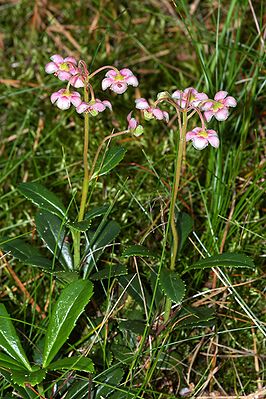Umbel winter love
| Umbel winter love | ||||||||||||
|---|---|---|---|---|---|---|---|---|---|---|---|---|

Winter loaf ( Chimaphila umbellata ) |
||||||||||||
| Systematics | ||||||||||||
|
||||||||||||
| Scientific name | ||||||||||||
| Chimaphila umbellata | ||||||||||||
| ( L. ) WPCBarton |
The Umbelliferous Winterlieb ( Chimaphila umbellata ), also umbellate Winterlieb or Wintergreen , is a very rare plant species from the family of the heather plants (Ericaceae) and the subfamily of the Monotropoideae (wintergreen and spruce asparagus plants). The genus Chimaphila includes four to five species.
features
The plant grows to about seven to 15 (20) centimeters and is a subshrub. The base of the stem is woody and pale yellow to reddish. The rhizome creeps far so that the plant usually grows in groups. The evergreen leaves are approximated like a rosette, spatulate, dark green, leathery, shiny and sharply serrated at the edge. The inflorescence consists of a terminal, loosely arranged umbel cluster with three to seven nodding flowers. The five pink petals are five to six millimeters long and when the flower is not yet fully open, they curve in a hemispherical shape. The short green style is heavily thickened below the stigma and optically quite dominant, which is typical for wintergreens. The flowering period extends from about the end of June to the beginning of August.
Like all wintergreen plants, the species lives in symbiosis with a root fungus ( mycorrhiza ). This surrounds the roots with a thick mycelium coat and supplies the plant with water and mineral salts, while the fungus, conversely, receives carbohydrates. The mycorrhiza also seems to be of decisive importance for the development of the seedlings.
Chromosome number
The number of chromosomes is 2n = 26.
Location requirements
The Doldige Winterlieb grows in lichen-rich pine forests on dry to fresh, nutrient-poor and moderately alkaline sandy soils. A socialization with other, also rare heather plants, for example the green-flowered wintergreen ( Pyrola chlorantha ), the moss eye ( Moneses uniflora ), the pear green ( Orthilia secunda ) or also with the spruce asparagus ( Monotropa hypopitys ) can be observed. The Doldige Winterlieb is a type of character of the Pyrolo-Pinetum from the Cytiso-Pinion association.
Spread, endangerment
The nominate form ( Chimaphila umbellata subsp. Umbellata ) occurs in northern Central Europe, in Northern Europe and in Russia - a focus is particularly in the Baltic Sea region . In Germany only the north-east German lowlands are populated very sporadically; the relatively greatest continuity is still achieved in Brandenburg . Due to anthropogenic changes in the landscape, especially due to extensive eutrophication by air, but also due to forestry measures, the populations of the Doldigen Winterliebe have shrunk very much. The excessive nutrient input causes succession of the herbaceous layer in forests; the lichen and hagermoss pine forests typical of Chimaphila and other wintergreen plants are transformed into willow pine forests. The pyrolacea are evidently gradually being displaced by the spreading wire smear ( Deschampsia flexuosa ), a forest grass. Other nutrient-displaying species appear later.
In Germany, the Doldige Winterlieb is considered to be "specially protected" in terms of the law ( Federal Species Protection Ordinance ). The species is also classified as "critically endangered" throughout Germany and Europe, and as "critically endangered" in various Red Lists of the federal states.
Subspecies
The following subspecies can be distinguished:
- Chimaphila umbellata subsp. acuta (Rydb.) Hulten : It occurs in Arizona and New Mexico .
- Chimaphila umbellata subsp. cisatlantica (SF Blake) Hulten : It occurs in Canada and the USA.
- Chimaphila umbellata subsp. occidentalis (Rydb.) Hulten : It occurs in Canada, Alaska and in the western states of the USA.
- Chimaphila umbellata subsp. umbellata : It occurs in Europe, Siberia, China and East Asia.
literature
- Garve, E. (1994): Atlas of the endangered fern and flowering plants in Lower Saxony and Bremen. Nature conservation landscape conservation Lower Saxony 30. ISBN 3-922321-68-2
- Henning Haeupler , Thomas Muer: picture atlas of the fern and flowering plants of Germany (= the fern and flowering plants of Germany. Volume 2). Published by the Federal Agency for Nature Conservation. Ulmer, Stuttgart 2000, ISBN 3-8001-3364-4 .
- Lexicon of Biology. Vol. 8. - Herder-Verlag, Freiburg, 1987. ISBN 3-451-19648-4
Individual evidence
- ↑ a b Erich Oberdorfer : Plant-sociological excursion flora for Germany and neighboring areas . With the collaboration of Angelika Schwabe and Theo Müller. 8th, heavily revised and expanded edition. Eugen Ulmer, Stuttgart (Hohenheim) 2001, ISBN 3-8001-3131-5 , pp. 726 .
- ↑ a b c d e Chimaphila in the Germplasm Resources Information Network (GRIN), USDA , ARS , National Genetic Resources Program. National Germplasm Resources Laboratory, Beltsville, Maryland.
Web links
- Chimaphila umbellata. In: FloraWeb.de.
- Umbel winter love . In: BiolFlor, the database of biological-ecological characteristics of the flora of Germany.
- Chimaphila umbellata (L.) WPC Barton In: Info Flora , the national data and information center for Swiss flora . Retrieved January 12, 2016.
- Map of the worldwide distribution of Chimaphila umbellata (various subspecies) at linnaeus.nrm.se
- Thomas Meyer: Data sheet with identification key and photos at Flora-de: Flora von Deutschland (old name of the website: Flowers in Swabia )


